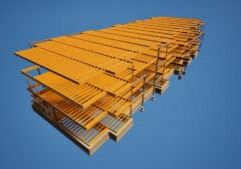“Obsession” with Modular Logistics Leads to Business Success

Carson Holmquist is the co-founder and CEO of Stream Logistics and Stream Modular.
Carson Holmquist admits he’s “obsessed” with modular logistics. The co-founder and CEO of Stream Logistics and Stream Modular is working hard to further the reach of modular construction by making transportation of modules easier and faster. His company is investing real dollars, $50 million over the next 25 years, to develop his company’s skills and provide the equipment and assets to make this dream a reality.
Holmquist began his career in logistics when he was in college at Arizona State University and was an intern for a start-up logistics company. “The industry was full of exciting challenges and there were a lot of different roads you could take within it,” he says. He was interested in the start-up business model and in 2012 decided to go into logistics with a business partner whom he’d met in school. Stream Logistics was born.
From the start they focused on what Holmquist calls “high stakes freight." These deliveries are very time sensitive, as many have crews and equipment waiting for them and they require specialized preparation and planning, much like in the modular industry. As the company performed more modular deliveries, they began to see a real need for specialization and improvements based on lessons they’d learned. So, in January 2023 they started a new division of Stream Logistics: Stream Modular, whose focus is solely on transporting freight for the modular construction industry.
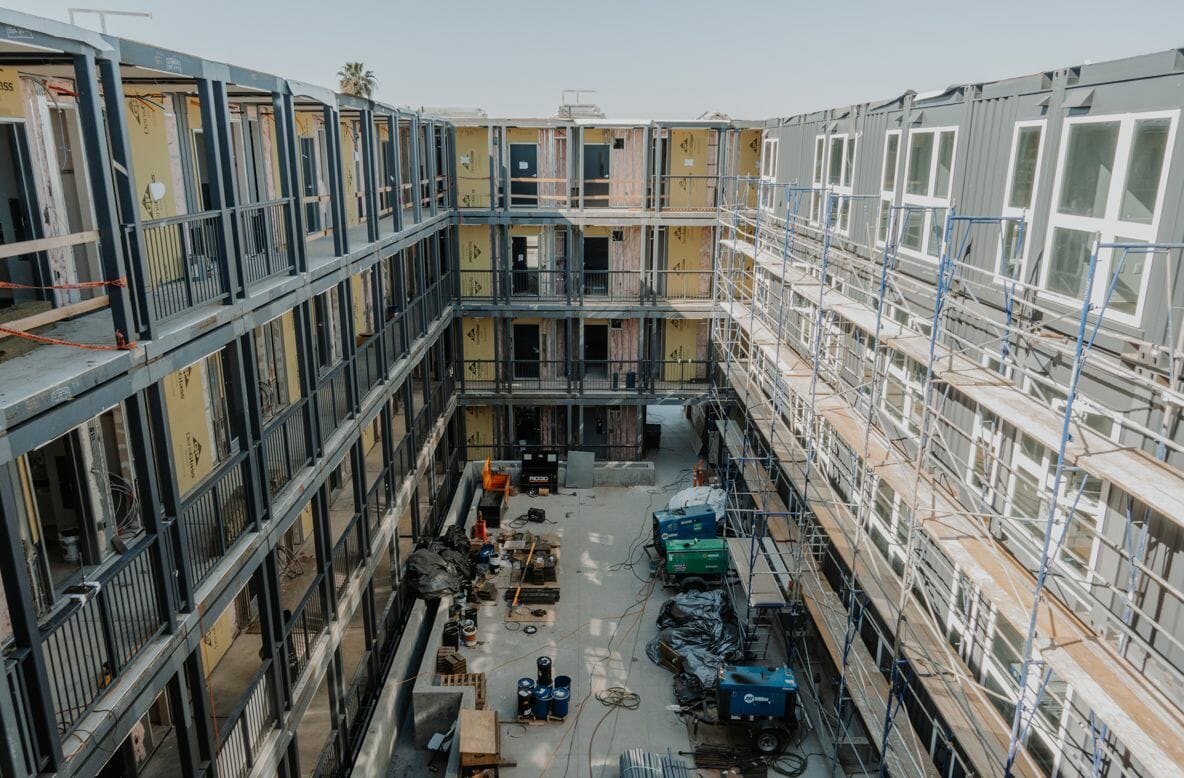
The interior plaza progress of the Hope Project, a modularly constructed low-income apartment complex in downtown Los Angeles, showcases the project undertaken by Silver Creek.
New Technologies and Lessons Learned
In the short time they’ve been in business, the team has learned a lot about modular transportation, learning more in four months than they had the last two years without the specialized focus. The team is made up of experienced logistics project managers who are revolutionizing how modular freight is handled through new technologies and lessons learned through experience.
One of the new technologies that’s improving efficiency is a specially designed trailer that allows teams to load and unload modules without the use of a crane. Modules are usually stored on jack stands or cribbing, and the specialized trailer is driven underneath this support structure. Then hydraulic pistons raise the trailer bed until the module is above the cribbing, and the truck drives off. The reverse happens when the module is delivered: the trailer bed is raised until it is above the height of the cribbing, the cribbing is installed, and then the trailer is lowered. This puts less stress on the structure of the module, preventing drywall cracks and popped nails, and it’s faster than a traditional crane lift. Holmquist and his team have learned many valuable lessons through their experiences, including the value of having boots on the ground in the first few days of a project. Most logistics companies don’t invest this additional time and cost into their projects, which can cause delays as drivers and construction crews have to deal with the fallout. Stream sends one to two project managers to the site, both before delivery starts to scope out the details, and during the first few days to help with last-minute glitches.
“We just did one in Minnesota where two of our project managers were on site for three days for the launch of a project. It was invaluable for them to be there, because if a project’s going to experience challenges, it’s most often in the first third of the project, when the pace and the rhythm is getting set.” The stuff that can really bog up the work is timing. Delays can be caused by manufacturing issues, weather, supply chain issues, and labor shortages. The team must always be prepared for delays and build them into their plans.
Holmquist recounts his first off-site panel construction project, where they were taking the panels from Arizona to Florida without a staging yard, so everything had to be just-in-time delivery. The team designed transit buffers, where every truck showed up a day and a half early and parked and waited in a lot that was less than 10 miles away from the job site. This allowed them to keep up with the deliveries and even get ahead if the installation crew allowed them to. The strategy proved successful.
On another project the project manager performed a site survey and found stored inventory, portable restrooms, and a fire hydrant in the way of the truck approach. The inventory and restrooms could be moved before the first delivery arrived, but the fire hydrant would be difficult to see in a large truck. The team attached a PVC post with a flag on top so the truck could always see it.
Without careful planning and visiting the project before deliveries start, both of these projects could have turned out much worse, costing everyone time and money. “This industry requires the best of our capabilities, which is really exciting and means with every project we’re going to grow and get better. And it also shows us that this industry needs something really special, something that the rest of the transportation industry wouldn’t intuitively know to do."
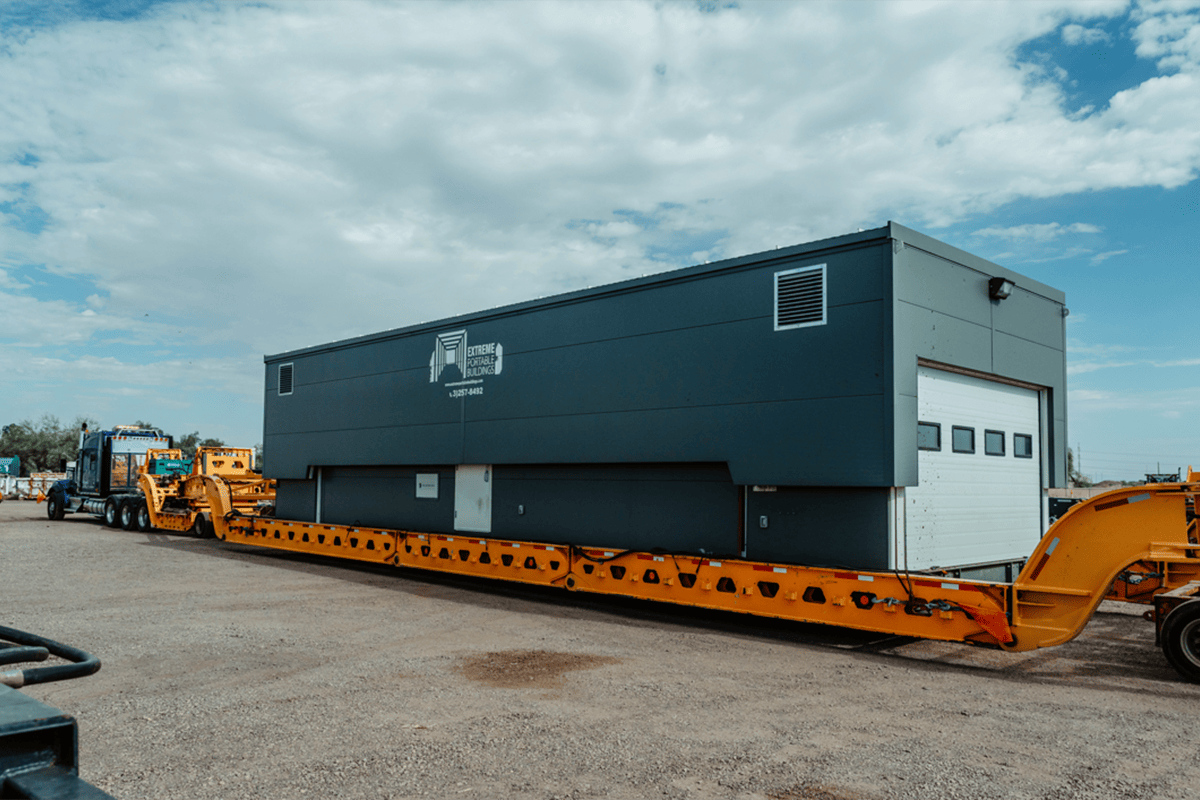
A massive modular industrial space for Extreme Modular Buildings is delivered from Sturgess, South Dakota to Phoenix, AZ, highlighting the transportation stage of the project.
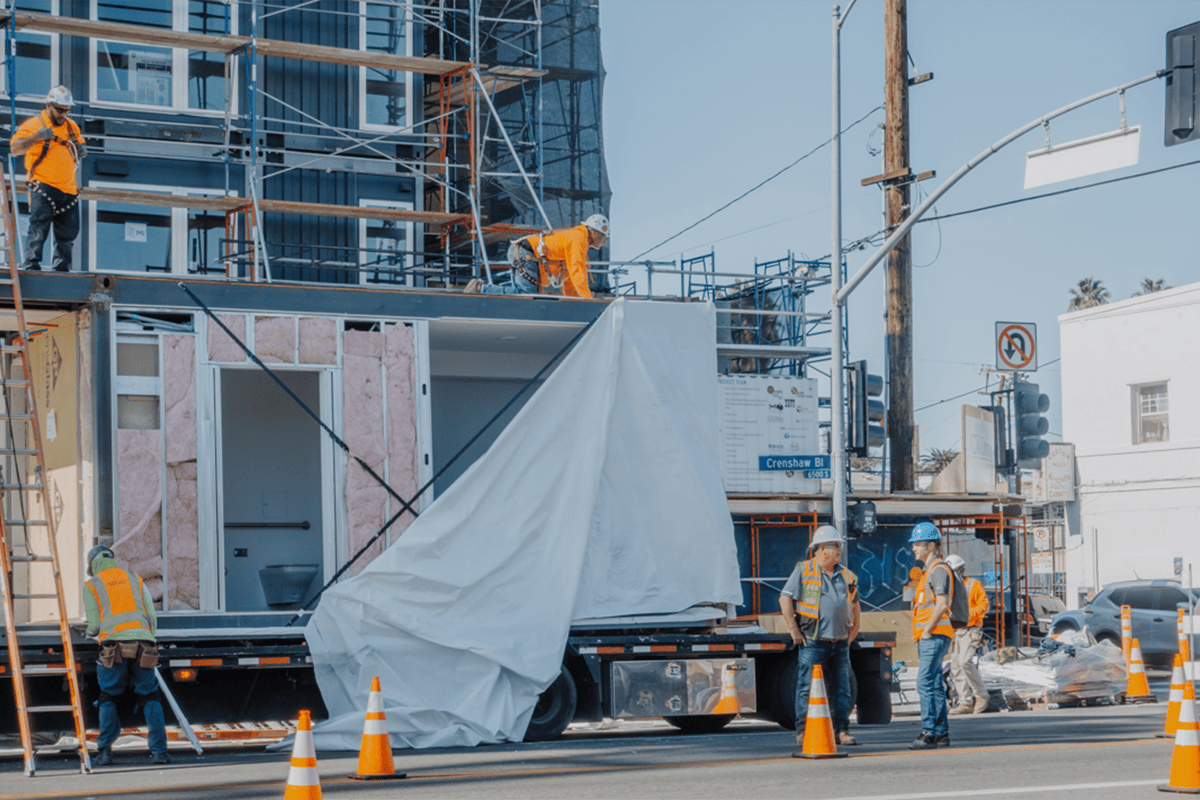
Another phase of the Silver Creek project captures the readiness of a module to be craned and placed onto a modularly built low-income apartment complex in Downtown Phoenix.
Getting Involved Early
Holmquist says the best time for his team to get involved is during budgeting. “We’ve seen so often a factory will come to us, we design a plan, then they realize their original budget wasn’t anywhere near close. And that’s a difficult position to be in because it’s going to eat into the margin of the project.” A couple of months before the project begins, the team begins to nail down the details of the job, including what permits are needed, routes to take, and timing of deliveries. Then, a couple of weeks before the first deliveries are made, the team really kicks it into gear.
Because of the different jurisdictions and requirements for transporting large loads, getting specific information about the job, including exact addresses, is key. Some highways have timing restrictions for large loads, so delays of even an hour can significantly affect the delivery schedule. The team must plan exact routing and timing to meet the production crew’s schedule, as the delivery schedule is determined by how many units they can install during a workday. All of this drives the need for resources: drivers, trucks, trailers, etc.
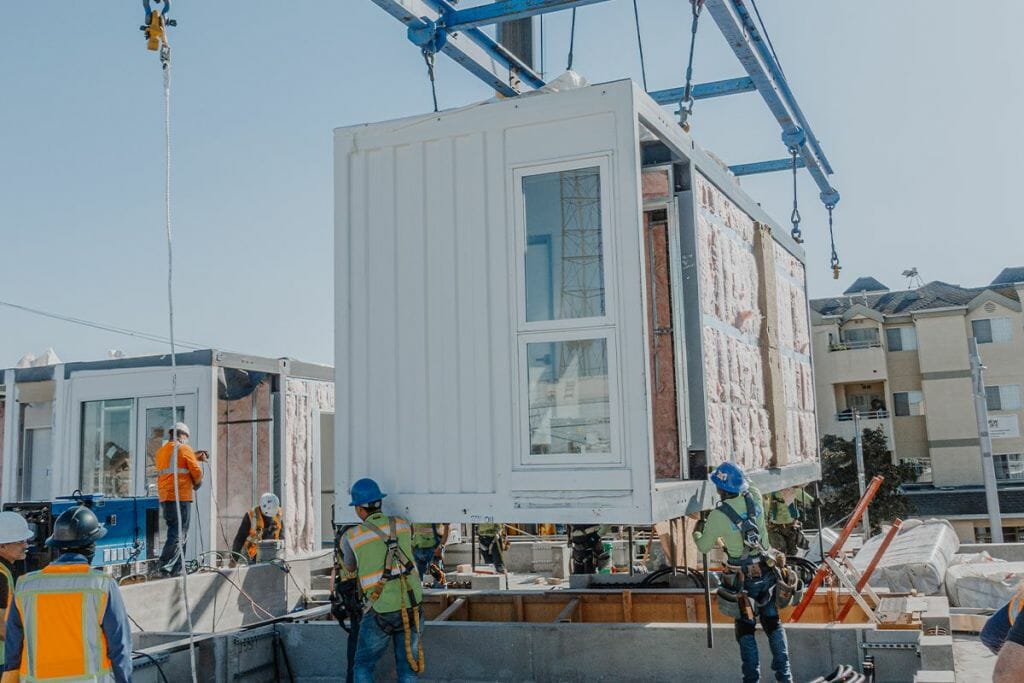
The “Hope Project” by Silver Creek reaches the craning and setting phase, illustrating the module being placed atop an apartment complex as part of the construction process.
Transportation Best Practices
Holmquist urges owners and manufacturers to invest in their delivery relationships the way they invest in their contractors and designers. “It’s very common for the factories to have strategic conversations with the construction crew. They probably happen dozens of times throughout the course of a project. It’s very uncommon to include the transportation company in those conversations.” Teams often don’t realize that small details, like the width of a unit, can have a significant effect on transportation costs and schedule.
Working as a team, factory, construction contractor, and transportation company, is key to project success. “It’s one unitary
process, a cycle, and so working together is very important. And it’s important to find a transport partner that’s looking to co-create solutions for the future of your company. This means it’s not just about this project today, it’s about investing in what’s needed to ensure that we’re getting where we want to go. Another best practice is to “make a commitment to maintain impeccable communication. So as soon as something changes, as soon as you have information, it’s passed down the chain to that critical team."
Making a Commitment to the Industry
“We want to help accelerate the adoption of modular construction. And we know that transportation can be a big impediment to the experience that the general contractors or the developers have. What we want to do is make sure they come back and do it again. The way transportation’s being done now needs to meet the demands of today, but we also have to keep an eye on the future and what needs to be developed to close that gap between now and where this industry is going. And we’re fully committed to it."
About the Author: Dawn Killough is a freelance construction writer with over 25 years of experience working with construction companies, subcontractors and general contractors. Her published work can be found at dkilloughwriter.com.
More from Modular Advantage
Behind the Design of Bethany Senior Terraces, NYC’s First Modular Passive House Senior Housing Project
As more developers seek to meet new regulations for energy efficiency, the team at Murray Engineering has set a new record. With the Bethany Senior Terraces project, Murray Engineering has helped to develop NYC’s first modular structure that fully encompasses passive house principles — introducing a new era of energy efficiency in the energy-conscious city that never sleeps.
How LAMOD is Using Modular to Address Inefficiency, Sustainability, and the Future of Construction
As developers, designers, and contractors seek to understand the evolving needs of the modular industry, no one is as well-versed in the benefits of going modular as Mārcis Kreičmanis. As the co-founder and CBDO of LAMOD in Riga, Latvia, Mārcis has made it his ultimate goal to address the inefficiencies of traditional construction.
From Furniture Builder to ‘Activist Architect’: Stuart Emmons’ Unique Journey
Stuart Emmons was fascinated by buildings at a young age. He remembers building sand cities with his brother during trips to the Jersey shore. His father gave him his first drawing table at the age of ten. Today, he is an experienced architect who received his FAIA in June 2025. The road he took is unique, to say the least.
Forge Craft Architecture + Design: Codes, Contracts, and Intellectual Property
Founding Principal and Director of Modular Practice for Forge Craft Architecture + Design, Rommel Sulit, discusses the implications of codes, contracts, and intellectual property on
modular construction.
Eisa Lee, the “Bilingual” Architect
Now as the founder of XL
Architecture and Modular Design in Ontario, Canada, she applies not just her education as a traditional architect but an entire holistic view on modular design. It’s this expansive view that guides her work on being a true partner that bridges the gap between architects and modular factories as they collaborate on the design process.
Tamarack Grove Engineering: Designing for the Modular Sector
The role of a structural engineer is crucial to the success of a modular project, from initial analysis to construction administration. Tamarack Grove offers structural engineering services — project analysis, plan creation, design creation, and construction administration — for commercial, manufacturing, facilities, public services, and modular. Modular is only one market sector the company serves but it is an increasingly popular one.
Engineer Masters the Art of Listening to His Customers
Since founding Modular Structural Consultants, LLC. in 2014, Yurianto has established a steady following of modular and container-based construction clients, primarily manufacturers. His services often include providing engineering calculations, reviewing drawings, and engineering certification
Inside College Road: Engineering the Modules of One of the World’s Tallest Modular Buildings
College Road is a groundbreaking modular residential development in East Croydon, South London by offsite developer and contractor, Tide, its modular company Vision Volumetric (VV), and engineered by MJH Structural Engineers.
Design for Flow: The Overlooked Power of DfMA in Modular Construction
Unlocking higher throughput, lower costs, and fewer redesigns by aligning Lean production flow with design for manufacturing and assembly.
Choosing the Right Ramp
Modular construction offers a compelling alternative to traditional methods for designing and building ADA and IBC-compliant entrances. By addressing the challenges of traditional construction, such as time-consuming processes, unavailable specialized labor, and variable field conditions, modular solutions provide a more efficient, cost-effective, and reliable approach.






